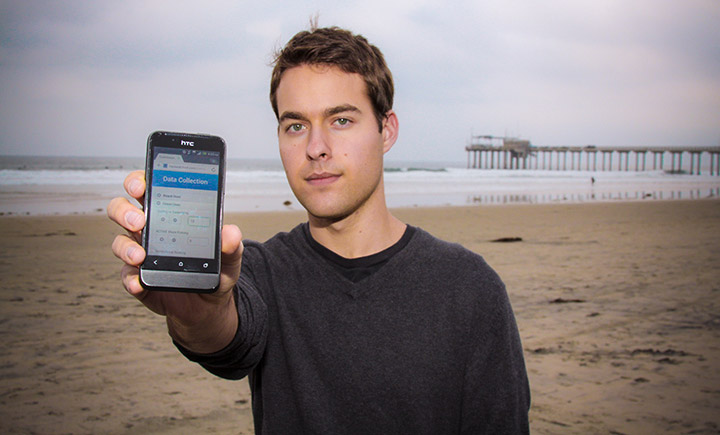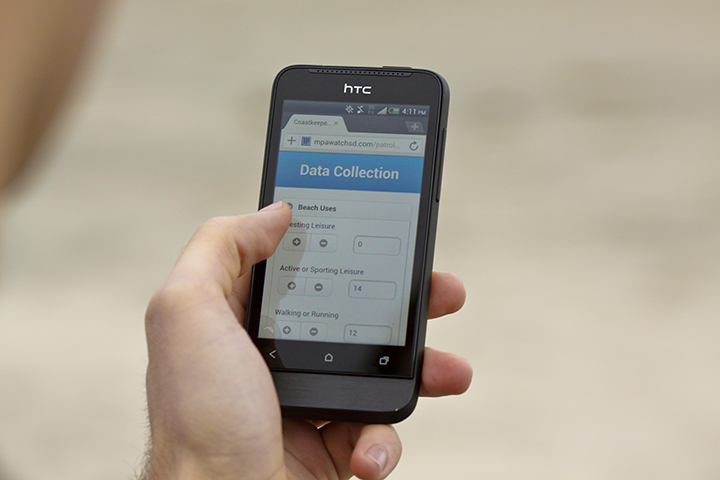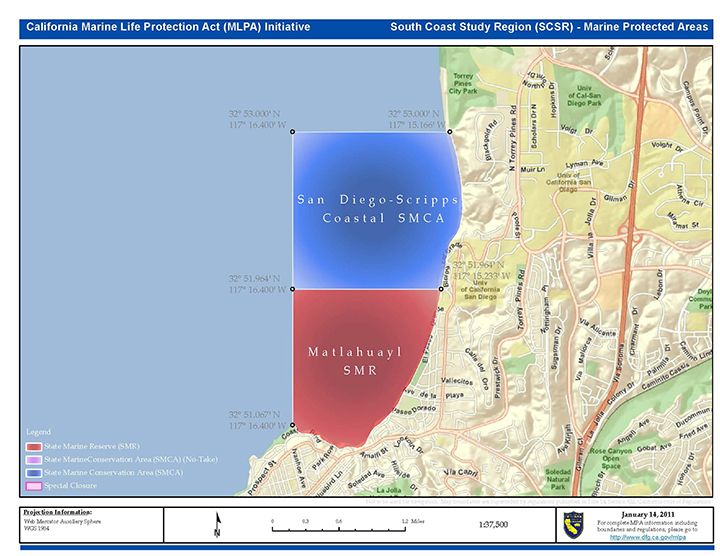By:
- Ioana Patringenaru
Published Date
By:
- Ioana Patringenaru
Share This:
Engineering Students Develop App to Help Protect Marine Conservation Areas

David Drabik co-led a team of students that helped develop a web app for San Diego Coastkeeper. The app will monitor the health of marine protected areas off the Southern California Coast.
A team of engineering students at UC San Diego has been working hard to help protect the beaches and waters off the La Jolla coastline by developing a web app that will allow volunteers to monitor the health of marine conservation areas. Volunteers will input information about human activity, pollution, and even poaching, into the app via an interactive form.
The student team is part of Global TIES, a humanitarian engineering program at the Jacobs School of Engineering that allows undergraduates to work on ambitious projects with nonprofit organizations and government agencies throughout the world—and at home. Students are working in partnership with San Diego Coastkeeper, an organization dedicated to protecting and restoring fishable, swimmable and drinkable waters in San Diego County.

The app allows volunteers to gather data about human activities, pollution and even poaching.
Coastkeeper plans to deploy teams of volunteers who can use the app to gather data in two areas in La Jolla. A pilot program is set to begin this spring.
“This is a tool that could save us a great amount of time,” said Coastkeeper’s Jill Witkowski, who worked closely with the Global TIES team. “This app could be the difference between having a volunteer program and not having a volunteer program.”
Before the students developed the app, Coastkeeper gathered the information with pen and paper before trying to compile and analyze it—a very time-consuming process. Now, volunteers will be able to use the app to record a wide range of activities, including people running, surfing, swimming or simply sunbathing. They can also record information about pollution, such as runoff, and littering. Finally, volunteers can also keep tabs on poachers who fish in marine protected areas, running afoul of Department of Fish and Wildlife regulations.
The information gathered then goes into a database. Right now, it can be exported into Excel for further analysis. But the ultimate goal is to build a tool that will enable Coastkeeper staff members to analyze the data within the app itself. The administrative panel will allow the organization to generate reports by area and type of activity, for example.
“We’re working with other environmental groups and scientists in California to assess the effectiveness of marine protected areas,” said Witkowski.
The marine protected areas that Coastkeeper plans to monitor with the app were created in January 2012. The Matlahuayl State Marine Reserve extends from roughly just north of La Jolla Shores to La Jolla Cove. The South La Jolla State Marine Reserve is off south La Jolla, starting south of La Jolla High and extending into Pacific Beach. Coastkeeper hopes that conservation will help restore the protected areas to their pristine state, attracting more visitors in the process. The organization plans to use the data collected with the app to document changes in usage.
The experience was a great opportunity for students to learn how to work with realistic constraints and meet deadlines, said Geno Pawlak, a professor of mechanical and aerospace engineering at the Jacobs School, who was one of the faculty advisors on the project. Students learned to respond to a client’s needs and to present their work, he added.
“I was very impressed by the students’ level of technical knowledge and motivation,” Pawlak said.
David Drabik, a junior and computer science major, is the project’s team lead this quarter. He said Global TIES helped him learn to communicate ideas and take everyone’s opinions into account.
He was inspired to become an engineer by one of his cousins, who was a computer science major. He plans to become a software engineer at a large software company.
Matt Murbach, a chemical engineering major and the team’s undergraduate advisor, decided to study engineering because he liked to see how things are made. He plans to go to graduate school and study alternative energy sources.
“I learned so much,” he said of his experience on the Coastkeeper project.
Students debated whether to use a native mobile app or a web-based app. They opted for the latter because it could be used on different screen sizes and operating systems. The team included computer science, electrical engineering, chemical, and mechanical engineering majors. They split into two groups; one focused on the user interface and the app’s front end, the other on the back end and administrative tool.
Students used jQuery mobile, a library based on JavaScript for the front end, as well as HTML and CSS. For the back end, they used Silex, a framework for PHP. The administrative tool was built using Twitter Bootstrap.
Coastkeeper is planning a wider deployment of the app by the end of the academic year. For more information about Global TIES, please go to: globalties.ucsd.edu.
Share This:
You May Also Like
UC San Diego is Strengthening U.S. Semiconductor Innovation and Workforce Development
Technology & EngineeringStay in the Know
Keep up with all the latest from UC San Diego. Subscribe to the newsletter today.




